|
|
Trip Report |
|---|---|
|
|
30.51969°N / 79.31597°E |
|
|
Jun 20, 2022 |
|
|
Hiking |
|
|
Summer |
Stories
Who are you? Ramana Maharshi to Dr. Paul Brunton. Only when you find an answer to this question - come and see me.

A noted British author who regularly wrote on spirituality, had come to India, to explore what he knew, and what he could learn from the spiritual gurus in India, about whom he had heard a lot! The question piqued his brain for a couple of days before he could meet Maharshi, and strike a conversation with him, which led to his enlightenment.

Upon being stressed out due to an operation his wife was supposed to undergo in the U.K., Lahiri Mahasaya, an Indian clerk working under the supervision of the British in the Military Engineering Department, assured him - Nothing will happen to her, and her operation will be just fine! Don’t worry! He thought his worker to be just consoling him, until when his wife arrived 3 months later, and told him that his clerk had come
to the operation theater and taken away all the pain that she was undergoing while the operation was going on.
A famous doctor who cured lakhs of patients, when falls sick and sees no cure in a remote place called Kumardubi, Sachin Baba, a mystic guru residing there cures him miraculously.
Various anecdotes on how the revered Ramkrishna Paramhansa promoted his disciples to seek unconventional ways of “finding yourself”, and not caring a bit for what the world would think of.
The above were just a few of the many stories that we heard, discussed, ruminated, and which made us deeply aware of the “power” out there, which some people call god, and which keeps things in balance in this world, while we trodded endlessly across mountains, over passes, jumping over boulders and streams, crossing broken bridges, and exploring jungles, all while on the ultimate Shiva trail - The Panch Kedar!
Seed
Sitting in a covered balcony in Kalimpong, with thundering rains outside, a coffee mug by my side, I picked up a book from the shelf, Panch Kedar by Debal Sen, a practicing Cardiologist out of Kolkata, and a nature photographer and trekker. 
I couldn’t read the entire book due to paucity of time. However, the book is written in the most lucid manner, where the author marvelously paints a picture of the Himalaya in the early part of the last century, when travel was limited to only a select few people, and his grandfather happened to be one of those people.

His grandfather took the entire journey of Panch Kedar by foot, in the absence of any sort of infrastructure, and vividly wrote about his travels in notebooks. The author retraces the steps of his grandfather, trying to identify with the people, landmarks, places of interest and most importantly, experiences which helped his grandfather remember this “pilgrimage” as one of the best there is!
I got so mesmerized by the book, its photos, the vivid description, and the vigor with which the author tries to fill in the shoes of his grandfather, that I decided on that very day - I want to do this pilgrimage, at any cost!
It took me 7 years before I could embark on this spiritual journey, to experience why Lord Shiva is called the “Mahadev”, which means - God of Gods!
Panch-Kedar
Post the fierce battle of Mahabharata, when the Pandavas were wanting to attain Moksha by going to the heavens through the Swargarohini Peaks in Garhwal, they couldn’t do so, as Lord Shiva was very angry and upset with them, for having engaged in this huge war, which led to innumerable deaths, including those of their brethren.

For an act like that, he couldn’t get himself to permit them an entry to the heavens, and according to him - there was no way for them to atone for their sins!

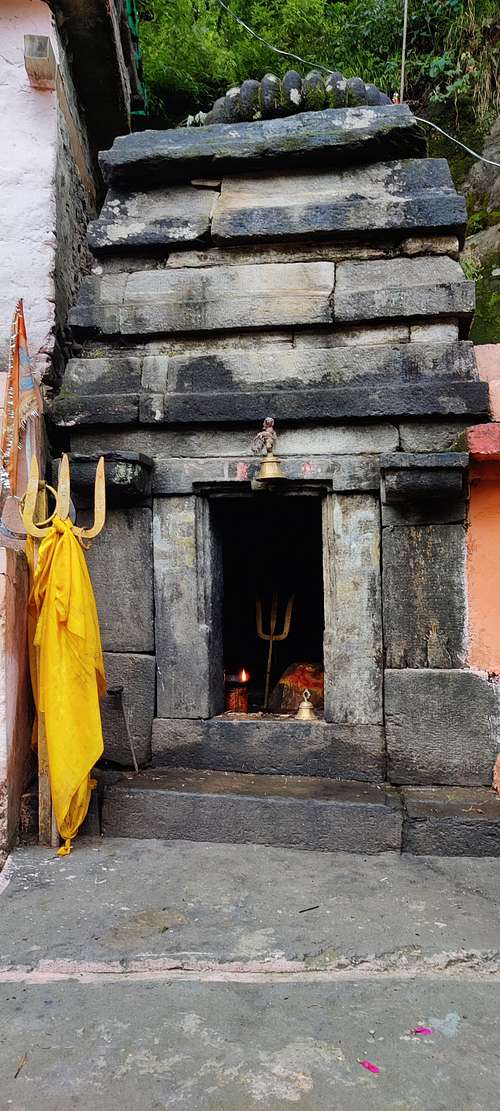
The Pandavas, to atone for their crimes, made it their goal to please Lord Shiva, so that he could allow them Moksha. So, their life goal became the search for Lord Shiva, who was supposed to have gone into hiding, and he didn’t want to be found out.
The story goes that once, while on their search, they found Lord Shiva in the form of a bull, grazing in the high mountains. As soon as they recognized him, Bhima caught hold of the bull’s tail, and wouldn’t let go.
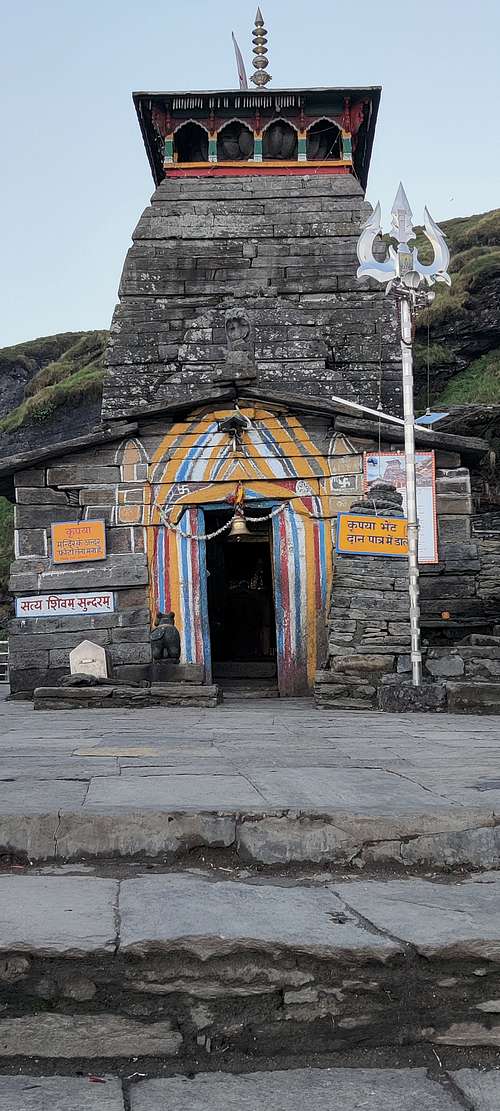
As Lord Shiva was angry with them, in a desperate attempt to not get caught, he dove into the ground, and emerged at 5 different places all across the Garhwal Himalaya, which is known as the Panch-Kedar. Following places were where he emerged:
Kedarnath, where the hump emerged.
Tungnath, where the arms emerged.
Face emerged in Rudranath
Navel and stomach emerged in MadhyaMaheshwar, and
Hair appeared in Kalpeshwar
It is said that after visiting all these five temples, one has sought the blessings of Lord Shiva. After years of trying to visit these temples, I finally got a chance to do so. And that too, with a colleague of mine, Rajib, who agreed to come along with me, when I asked him on the 11th hour!

Rajib Da

A man who joined me in our organization abou 4 years ago, is a truly multi-faceted personality. He has vast experience in the industry, having worked in Reliance, Schlumberger as well as CWPRS, a central government department, he can pretty much speak on any topic under the sun!

A man who swam through the Ganges in Kolkata, in full monsoon - letting his colleagues at Ramkrishna Mission to pretty much declare him dead, who’s taken an expedition to Antarctica, with the who’s-who of the Geophysics community, to study glaciers, climbed atop a mountain to send out SoS signal in dire emergencies, has swam across Khadakwasla dam in Pune numerous times, ran multiple marathons (the latest one being a 25K mountain marathon), and is as technically sounds, as is physically fit and intellectually abreast about the happenings around the world.


It was indeed an honor to have walked the trails of the Himalayas, with this man, listening to the numerous stories - ranging from how his teacher was nominated for a Nobel prize to how interpretations of ancient scriptures related to the multiple gods in India. You name a topic - and this man has knowledge of it, and not just knowledge - deep knowledge.
Kalpeshwar

To save time, I booked a very badly timed flight, which took off from Pune at 2.30 am, for which I went to the airport at 10.30 pm. A whole night of travel, followed by travel to Rishikesh through the local transport left us dead tired, standing at the Rishikesh bus station, totally clueless on how we were supposed to go up in the mountains, to Pipalkoti and further to Helang and Urgham.
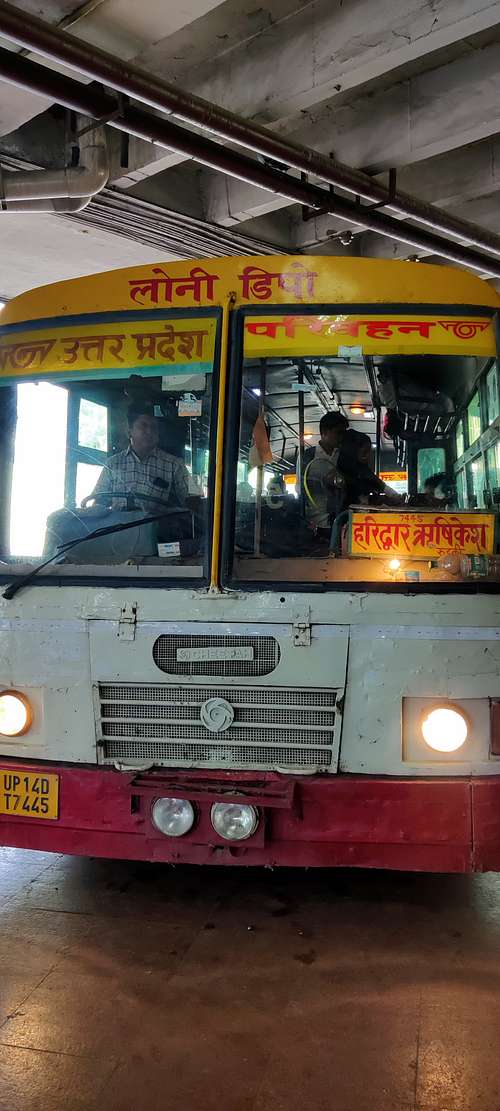
All buses and taxis had left for the day, and it was close to 3 pm, when nobody goes up in the mountains, with monsoons approaching.

With backpacks on our backs, people were either coaxing us to pay ridiculous amounts to take us up, and telling us to stay the night in Rishikesh, to catch the early morning bus at 5 am to Joshimath, which will drop us off at Helang. Wandering the street around the bus stand, all kinds of agents bumped into us, among them one guy who was an ardent Shiva follower, who, listening to our plan - took it upon himself to arrange transport for us, no matter what!


And, he did arrange a taxi - which would take us to Rudraprayag, from where we would get a taxi to Helang the next day, or even on that day. However, while going to Rudraprayag, I felt so tired and exhausted, that I just couldn’t keep my eyes open! It was as if all my energy had been sapped away from my body, and I don’t even have the strength to lift my hand! I was utterly tired, which led us to take a pit-stop in Srinagar. We ended up paying more to the driver, as we got dropped off early, but it was an absolute essential. Scouting for the hotels was something that Rajib did (all thanks to him, as I was fast asleep in the car). Some rooms didn’t have a fan, some were right on the main road, with blaring horns everywhere, but he finalized on one, and I just crashed on the bed - to be woken up by Rajib, to have some dinner. He found a guy who would deliver basic food to the room (as the hotel didn’t have any facilities).

I remember eating rice in a dazed condition, only to be woken up in the morning for a cup of hot tea - Rajib had managed to convince that guy to deliver morning tea as well!
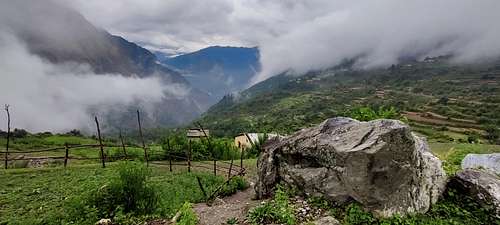
A fresh morning with a good night’s sleep, tea and some breakfast - and we were good to go! But, how do we go?



There wasn’t any taxi/bus/cab etc. at that time in the morning. With hope in our hearts, and chanting Om Namah Shivay, we marched ahead on the road….and about 20 minutes into our march, we showed our thumbs for a lift, and a guy stopped. He had started driving from Delhi the previous night, and was visiting a relative who had had a death at home. He told us that he usually never gives lift to strangers, but we looked “decent travelers” to him, which made him change his mind, and allowed us to get tucked in, in his car.
While he gave us a lift, we paid for his breakfast, and he dropped us off at Karnaprayag, from where a further journey to Helang and onward to Urgham still remained. We had gotten into the habit of not waiting at one point, but to constantly move ahead, with a hope that things would materialize, and they did! So many times, we were just uncertain of what lay ahead of us, and everytime, something or the other worked out.
While walking across the bridge on Karnaprayag, we started waving our hand to cars, and one guy stopped. After haggling over the money he was demanding, we settled on an amount for him to drop us off at Helang. At Pipalkoti, he haggled even more, and demanded some more money for which he could drop us off to Urgham, which is a further 13 km in the interior, from the highway.

When we reached Urgham, it was raining. A phone call to Mr. Anil Kumar, for locating his homestay, and one guy shouted out to us from the middle of the field. That’s when we realized that his homestay was accessible through a cobbled trail, which wound around a rice field to go to his place. We were greeted with a hot cup of tea, with some snacks. By the time we settled in, the rains had gone away, and the weather had turned awesome with sky a golden yellow, just post monsoons. The village, with its multi-colored homes looked like they'd been washed away by the rains, and stood bright, against the green fields and the evening sky. It was early evening, but the temperature had dropped and it was very pleasant.

After lunch and a short rest, we decided to head to the first of the Panch-kedars - Kalpeshwar Mahadev! This is not a trek, but a walk on the road, which was getting built, when I visited the place with my family. It was equally beautiful at that time, however because of the monsoons, the environment was serene and there was calmness everywhere. Village folks were chatting, having tea, going about their regular jobs, and were in general - content with their lives!

We decided to stroll towards Kalpeshwar temple, but little did we know that the stroll would turn out to be around 9 kms. While going to the temple, Rajib’s phone started ringing with a Bengali poem.

He was surprised, and so was I. As usual, without any spectacles, he held the phone close to his eyes, expressed shock and disbelief, pressed a few buttons, stopped the poem, and we walked on.

I didn’t realize or feel anything odd or off, and we chatted our way to the temple. At the entrance, is a place where a group of Sadhus stay, with one of them having stayed there since the past 40 years. We visited the temple, where the hair of lord Shiva is worshiped. It’s a relatively small temple, when compared to the famous Kedarnath temple, and not many people visit this place. There wasn’t anybody at the temple, and the priest had gone to run some errand. So, after our prayers, we took a few photos, which the priest saw, and boy - was he angry! Apparently, there was a board tucked away in a corner, which said - no photographs allowed, which we both seemed to have missed. We just apologized for our mistake, and went to the abode of those 4-5 sadhus, who were preparing their meal for the evening.

Our conversation was a mix of words borrowed from Urdu and Hindi, which they rightly corrected, by giving us alternate words in chaste Hindi. The discussions ranged over topics of good/bad deed, moksha (escaping from the birth-death cycle), wormholes, time-warps, concept of singularity with time-bending, powers of sadhus (one reference was to the famous tale which speaks of a Sadhu who was known to perform pooja at Badrinath and Kedarnath, on the same day!), Einstein’s famous equation, and its relevance to the knowledge that they had. It was a fun evening with us learning about their lives, since how long they’ve been staying there, and how much they travel between pilgrimage sites. One of the sadhus knew our guide in Ransi very well, as he claimed that he was the one who showed the route to him for hiking from Madhyamaheshwar to Kedarnath, a plan we had chalked out as well.

After a hearty chat, we started walking back to the homestay. Again, Rajib’s phone rang, and this time - a Bengali song started playing!
He took out the phone from his pocket and showed it to me - it had no live apps running, and on top of it - it was on airplane mode! Plus, he wasn’t aware of any songs being loaded on his phone - ever! Standing almost in the middle of the forest, with the sun setting at a distance, light showers on us - I had goosebumps! I couldn’t believe what was happening!
The song translated to - “My love, Thank you for fulfilling my wish”.

This is when Rajib told me that Maya (his wife), who had expired in April of 2021, was an ardent follower of Lord Shiva. She always wore a “rudraksha” bead in whichever necklace she was wearing, and had a lot of photos of Lord Shiva in her home-temple, along with multiple Shivlings.
Upon listening to what he said, and the experiences that we had, I blurted out unknowingly and instantly - “She is with us”! She is worshiping along with us in the temple that we just visited, and will be with us when we finish the Panch-Kedar! The mere thought and my observation got Rajib a little teary-eyed, and he nodded with a smile.


On the way back to the homestay, I could see him lost within himself. The rains had given way to clouds, which were crowding up the valley in front of us, while we slowly meandered our way through the picturesque village of Urgham to our homestay. I could see tears in Rajib’s eyes, and maybe, to hide them from others around, god started showering us with rain. When wet, it is difficult to see tears in one’s eyes. I made a small video call to my folks from there to show the beauty around, and after a cup of tea at a small dhaba, we headed back for dinner and good night’s sleep.

Rudranath

Anil Kapoor from Kalpeshwar, at whose place we had stayed, was hell bent upon taking a guide along with us, all the way to Rudranath, as there were supposedly places where we could get lost in the mountains.

However, we both knew the route, I had seen it on the map, so we politely declined the offer. He was good enough to come along with us to the border of Urgham village, where he bid us farewell, and went back home. We slowly started treading on the beaten trail, which slowly ascended through the forest. We were able to see the entire Urgham village, and as we ascended further, we could also see the snowclad peaks behind the village.

It was an amazing sight to behold. About halfway through the climb, we were overtaken by two ladies from the village, who were heading into the forest for some herbs. After they overtook us, I realized that Rajib was slowing down, as the ascent was quite steep, and both of us had full backpacks on us.


I went a bit ahead, and saw them stopping for us. They offered help by asking if they could carry out backpacks.

As I was fine with mine, I requested them to carry Rajib’s. We discussed that they would only carry it upto the pass at the end of the climb, after which the descent starts for the village of Kalgoth. I shouted out to Rajib, and told him to leave his backpack where he was, as one of the ladies went down to get it.
We took a halt at the pass, when she handed over the backpack to him, and we bid goodbye before the descent began. I made the mistake of asking them how much we should pay them, to which they got a bit offended, as they told us - they had helped the “old man” out of humanity, to which we were trying to put a price tag. I apologized, and we began our descent feeling a bit shameful, as we couldn’t gauge their intentions. However, we did discuss that had it been a male, he would’ve definitely asked for money to help out, hence our request.



The descent to Kalgoth was straightforward, with sweeping views of the valley that opened up in front of us, with villages perched atop various flanks of those mountains. Upon entering the village, we enquired about our next stop - Dumak, where we intended to stay for the night.

We also discussed the possibility of finding someone who would carry Rajib’s sack all the way to Rudranath, so that he can walk in a more relaxed manner.

The reason he was getting tired with the heavy backpack was that he didn’t get enough time to practice before we headed out to the mountains.

We took a rest at a place just before the village, and asked for help. We were directed towards a home which was also a homestay, where people could help us, to maybe get someone to carry his backpack, and come with us all the way to Rudranath. However, when we reached that home, the only owner was himself in pain and agony, as he was unwell. But, he was courteous enough to get us each a cup of tea, while we had our lunch, which we had packed from Urgham.
Unlike the previous day’s weather, it was hot and sunny, but a cup of tea with Parathas from Anil Kumar freshened us up immensely, more so with the views that we had in front of us. Seeing the guy in pain, we wondered what would happen if there was a medical emergency in this village, or for that matter - any village in this region? The owner told us that the state government intends to build a road up to this village, which will help its residents in seeking medical help if needed on an urgent basis. With prayers in our hearts, we set out for Dumak, the next halt, which was in our sight - but little did we know what kind of difficulties we were going to face to reach there!
On the way, a road diverged into two, and we asked a local which one to take. He suggested we take the higher road, as the lower one went all the way to the river, and if we see the bridge to be broken, we will have to climb up all the way again. So, we took the route suggested by them, and that was a big mistake! The route led us to a section, where the entire route had been washed away by a landslide, so we had to climb up and down huge unstable boulders, which was a risk. While cautiously treading on them, even if one of them moved onto our legs, we were done! We somehow managed to cross that section of the road, but we didn’t know of a more risky adventure which lay ahead of us.
At one point on the trail - the trail just finished!

There was a thick bush with a rock face right behind it, and the trail just seemed to end there. We were honestly surprised. Rajib went ahead and looked, but didn’t find anything.

I went through the bushes, and saw a trail going down to the rivulet flowing at the base of the valley. So, I called Rajib, and we both went on that trail. The trail was maybe just 8 inches wide, with a drop of around 80 - 100 feet on the other side, straight down to the rivulet.

There were a few small branches of the bushes we could hold on to, but nothing solid, so we had to rely on grass blades. A point came on the trail, where a huge rock jutted out from the mountain side on our right, and this had to be navigated with utmost caution.

I was aware of such situations, and I told Rajib about the risk of the rock giving a push to our backpacks, and us going down the slope in a free fall! As much as possible, I tried to see beyond the rock, but couldn’t see anything beyond that point, so wasn’t sure if the trail does go beyond that point or not. What if there was a straight fall ahead of it? How would we tackle that, as we didn’t have any rope or anchoring equipment with us. Rajib also voiced the idea of throwing the backpacks at the base from there, while we navigate through the tight spot, which I firmy declined, as the bags would get completely torn.

The situation and location was dangerous, and Rajib was scared to tread further. So, we went all the way up again, to the point where the main broad trail ended, and thought of what to do, and how to go ahead, as we could see the trail ahead of us, beyond the small rivulet.

I told Rajib to stay put, as my gut feeling and experience of having roamed the mountains told me that there is a 99% chance that the trail would continue further.

So, I took my pack and decided to overcome this obstacle. I decided to put my pack around the rock, hopefully at a place from where it won’t roll down, and then go all by myself. If it worked, then I would tell Rajib to do the same thing. At the precarious spot where the rock jutted out, I firmly planted my feet on the trail’s wet soil, and started removing my pack from the right hand side, which is natural for me. As soon as I got the pack out, it hit the rock, and I got a push back, and at that very moment, I realized my mistake - I should’ve removed it from the left hand side, which would have avoided the pushback from the rock. Now, that option was gone, and the only option left was - to pull the backpack up with all the strength that I had, and carefully throw it beyond the tricky point, all the while ensuring that none of the feet give way, hurling me down.


My right shoulder’s rotator cuff problem wasn’t going to help, and neither the hiking sticks on both sides of the pack helped. Still, I summed up all my strength, and gently threw the pack on the other side, in a hope that it wouldn't tumble down. It stayed put.

Then, I gently went past the rock, to gladly see that there wasn’t any drop, but a trail - the same size though - that headed down.

Happy that my judgment was correct, I went past the rock again, to go get Rajib, and his backpack. By the time I reached, there was a local guy who had appeared out of nowhere, and was speaking with Rajib, to whom Rajib had asked for help. He carried Rajib’s backpack across the point, and we all descended the treacherous face with a sigh!
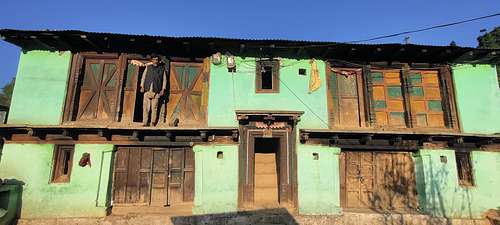
Dumak was just half an hour away, which was a great relief. Considering that we had lost a lot of time in this place, we decided to not head further to Toli Bugyal, but stay the night in Dumak.

When we entered Dumak, we couldn’t initially see anybody. However, towards the middle of the village, there were people playing cards. One of them asked - are you guys looking for a place to stay? On nodding, he pointed us towards an elderly gentleman deeply engaged in playing cards. He told us to give him a few minutes, so that he can show us around.

This is an interesting gentleman - Mr. Pratap Singh, who coincidentally runs the homestay called “Cafe Rudransh”, nestled in a corner of the last village of this district - Chamoli. The village is so remote that the earlier month, a team of election officials had visited this place to understand the extent to which their staff has to go, for getting the electoral process done, and what kind of difficulties they face, while on the job. They stayed at Mr. Pratap’s homestay for 2-3 days, to understand the problems being faced by the villagers, as well as the issues that their own staff face, when they walk 2-3 days, to come to this village, so that a couple of hundred people can cast their vote! Hearing this, my already huge respect for the election officials grew fourfolds, as these are the ground warriors who are ensuring that the principles of democracy are followed, and last adult in the last village of a highly mountainous district like Chamoli also gets a chance to cast his vote, thereby exercising his/her fundamental right.


Tales from discussions with the election officials as well as the SDM-Saab (Sub-Divisional Magistrate) started pouring out from Mr. Pratap, who interspersed them with his various experiences of having traveled the length and breadth of the country, as an Indian Army soldier. He had stayed in Pune for about 3-4 years, and had a special place in his heart for the city.

He loved the weather of Pune, and took it upon himself to serve us with utmost respect and honor, as we were guests in his village. For the service he gives, he charges literally peanuts, and says - You all are pilgrims of Bholenath (Lord Shiva), I am blessed to have you at my place!
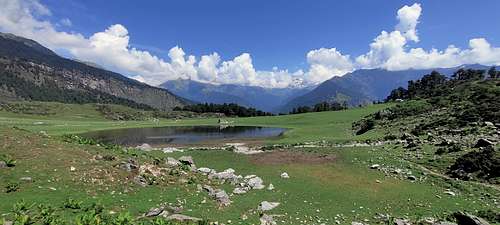
As soon as we entered the homestay, he served us tea, followed by snacks in the evening. The tea and snacks sessions were replete with chats about the region, politics, how people in his village sometimes behave irresponsibly, and how difficult it is to go get basic stuff while in winters it snows heavily over there. He had two sons and one daughter, one of them being in Dubai while the other was in Ukhimath, where he runs a small hotel.

The daughter was studying in her final year in Rudraprayag, and he decided to return to his village upon his retirement, to open a homestay for travelers and hikers like us.

In fact, if you try to find a stay in Dumak - Cafe Rudransh is the only thing that pops up on the internet, however as there is no telephone range in this region - one can’t call and connect with him. We soaked in the sun while laying down on the lawn in his compound, and then went for a stroll in the village, to witness a beautiful sunset on the magnificent Nanda Ghunti and the mountains beside it. The massive face of the mountain shone in an orange color, as the sun bid goodbye to it.
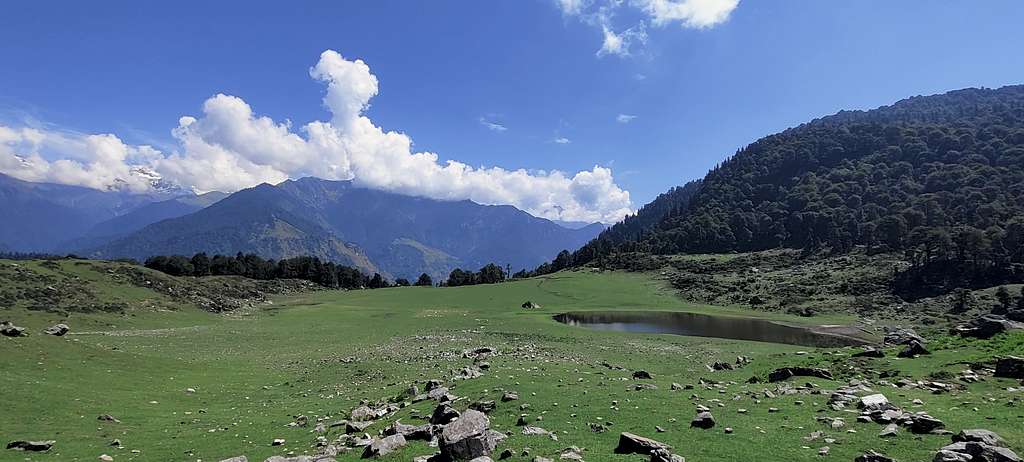
While returning from the field, we witnessed a very interesting thing - in one of the rooms of the only house in that village, in one of the corners - there was a metal wedge that was driven in the wall. A lady was sitting in front of the wall, and talking by herself. At first, we both thought her to be crazy, however we were told later that this is the ONLY spot in the entire village where connectivity is available, and one can speak by placing the phone in a particular position!

It was amazing how folks found this out.

I immediately took the opportunity to connect with my folks back in Pune, and tell them that both of us are ok, and we don’t have any connectivity for the next two days.
We headed back to the homestay, and Mr. Pratap had arranged a spread for us as dinner. It was amazing to see how well he was treating his guests, and we could sense that it was a combination of his military discipline and caring nature that led him to be such a great host!

There was hot water, a washbasin, nice comfortable rooms with good beds and blankets, and working charging points.

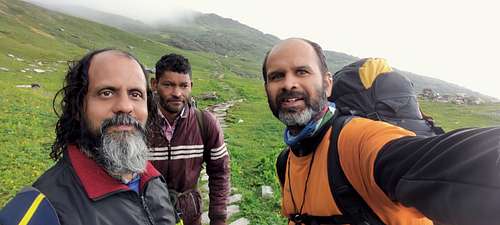
As Rajib was getting tired carrying the heavy backpack, we asked Mr. Pratap if he knew someone who could assist us with showing the route via Toli Bugyal and Panar to Rudranath, and maybe, carry a few things from Rajib’s sack. He was kind enough to introduce us to someone in his family - Anand, who agreed to come with us. Both of us gave him some stuff from our sacks, and we agreed to start early in the morning the next day.

The trail from Dumak to Rudranath goes through valleys, meadows, river crossings and open skies. An initial descent all the way down to the river led us into a forest, where probably we were the only three people walking.

We could hear birds chirping throughout the trail through the forests, and I wondered if I could hear any animal as well. When we crossed a bridge over the river, Anand told us that there are bears around, but they are higher up on the mountains, so we need not worry about wild animals. However, they do come near this bridge for drinking water.

Anand showed us a place where for the previous two nights, a large group had camped, and he took pride in showing us that the group had NOT left any garbage anywhere. Further, he told me that it’s not the outsiders, but the locals who have a terrible habit of throwing garbage/plastic all over the trail, whenever they eat either biscuits or gutka. We both found it quite funny that outsiders care so much about the beauty and environment, but the locals sadly had no respect for the same.

A couple of switchbacks later, all of a sudden, the sky opened up, and we were gazing at beautiful meadows with a lake in the middle of it. I took a few pictures while Rajib and Anand came up to what they call Toli Bugyal. Bugyal in the local language means meadow, and it was indeed mesmerizing to see the beauty all around, especially that the clouds had given way to the sun, which soaked all the beauty in it’s sunlight, right from the snow-clad peaks in front of us to the tiny dewdrops on the leaves. A short walk to the only place where we could get something to eat or have tea.
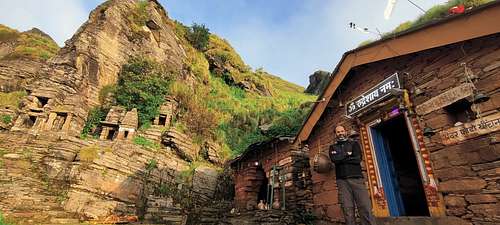
A couple of cups of tea, along with the breakfast that Mr. Pratap had given us was all we wanted, while looking out towards the beauty around us. The guy who runs the shop has also planted a small section of land in front of his shop with mustard seeds. It gave him the seeds for cooking as well as the leaves for vegetables. Rajib was a bit tired, so he took a small nap while I just soaked in the sun.

Anand told us that once we reach Panar - it’s just straight from there. Now, this is where interpretations change between people from the mountains and us city people. The climb from Toli to Panar was quite steep, but once we topped out the climb, we were surprised to see “no straight portion”, and Panar was yet to come. While walking on the trail, which had continuous ups and downs, we got a place to rest. Rajib gorged on the chocolate that he had got, as he terribly needed energy, while I took Anand’s phone to make a phone call to my folks, telling them that we were fine.

A couple of kilometers away, we reached a point which is called Panar, where the trail from Sagar village comes up. This is a critical point, as Rudranath was a further 8 km from this point, and earlier there used to be 2 - 3 dhabas where one could take shelter or replenish himself, if he felt tired. However, the forest department had taken down all these dhabas, and there was absolutely no place for refuge, in case it rains, or someone feels hungry/tired/thirsty - for the last 8 km up to Rudranath.

We decided to keep Rajib’s backpack at a dhaba, and just carry his sleeping bag and basic clothes in a small sack. While Anand went and gave his pack, Rajib took another quick nap out in the open, lying down on the grass. I asked him if he was ok, as he seemed very very tired. I was a bit concerned as there was still 8 kms to go. But, one good decision of letting him go ahead, while I and Anand caught up with him worked in our favor. He jutted out on the trail, taking all the water we both had, so when I and Anand were thirsty, we couldn’t do anything but shout out to him, hoping he would hear us and stop. After a few shout outs, he heard us, and we got water to drink, and our parched throats were at peace. Rajib seemed fine, but a few drops of rain on me shook me to the core. Had we gotten drenched in rain, we just had one set of spare clothes, and with no shelter (not even a natural/rock shelter), we were bound to get completely wet. But, I guess, my prayers worked yet again. I recited the Shiva prayer that I usually do everyday, praying that it doesn’t rain. And, it didn’t rain! Lord Shiva indeed was with us.

Crossing over the pass called Pitradhar, we were getting anxious to see the temple at almost every turn, and every turn was teasing us. A few shepherd huts and their dogs welcomed us on the way. Finally, after about 7 kms, Anand showed us the temple at a distance, which looked so pretty! Amidst green rolling hills - there was this temple at the end of the trail, with an awesome view of snow-clad mountains behind it!

We raced up to the temple, got ourselves a place to sleep for the night, and visited the temple for the evening aarti. It was a marvelous aarti, with the head priest performing it everyday at around 7 pm. As mentioned earlier, Pandavas are supposed to have built these temples to please lord Shiva, but what caught my attention was a series of small temples built right outside the main Rudranath temple, for the individual Pandavas.

All these were cut out in stone, giving a feeling that the Pandavas were just outside the abode of lord Shiva, in case he needed anything. The temples looked equally marvelous and were a sight to behold.
We were tired, so we decided to take proper darshan early in the morning, as the temple opened up at 5 am. The accommodation charges included dinner, so after a sumptuous dinner with a couple from Delhi and a group of Bengali Senior citizens, we got into our sleeping bags in a room filled with youngsters from nearby, who were all excited to be on this trek, and speaking and shouting loudly to express their enthusiasm, coupled with songs being played on their respective phones. Amid the cacophony of sounds, we fell asleep.

A quick darshan of the lord Shiva at the temple, and I advised Rajib to go ahead. Fresh from a night’s sleep, he just sprinted ahead, with me and Anand going slowly towards Panar. There is a diversion on this route, which goes to Anusuya Goddess temple, and comes down to the village of Mandal. Initially, we had planned to take this route, but due to the delay and with our main objective being the Panch-kedar, we gave it a pass, and continued on our pilgrimage.

A good hearty breakfast at one of the dhabas on the way down from Panar, we both sped our way down the steep descent. On the way, I met a friend of my colleague, Prof. Dandage, who used to work in the University of Pune. It feels good to chat in Marathi, in such far-flung places, as it reminds you of your homeland, family, people, food, culture etc. We caught up with Rajib, and when he wanted to take a short break, I went ahead and reached Sagar, to finally rest for a while. About an hour later, Rajib and Anand came. Anand had already spoken to someone in his family, who was ready with his car to drop us off to Chopta, the base of Tungnath.


The descent from Rudranath to Sagar was one of the most tiring ones on this trek, as the worst part was - it took almost an hour for the main road to come, after we crossed into the boundary of the village of Sagar.  A well-built entrance at the road welcomes pilgrims to start the climb towards Rudranath, where most of the people rest in Sagar, before heading to the temple.
A well-built entrance at the road welcomes pilgrims to start the climb towards Rudranath, where most of the people rest in Sagar, before heading to the temple.
Tungnath
A nice lunch in Sagar, and we climbed up (in a car) significantly to Chopta.

The driver told us that when this road wasn’t built, people used to come to Tungnath via a route that climbs up from Mandal. A mere thought of this climb made shivers run through our spine, as it would definitely be a huge altitude gain!

Tungnath is known to be the highest Shiva temple in the world, at an altitude of 12,106 ft. above sea level. From here on, the district changes from Chamoli to Rudraprayag. Compared to it being the highest Shiva temple, the hike up to the temple is relatively easy, at 4 kms from Chopta. It’s a well-cobbled road where ponies ply to take pilgrims up and down from the temple premises.

After a gruesome descent of Rudranath, we had planned on staying over at Tungnath, as 4 kms wasn’t a big deal.

We placed our sacks with a shop owner at the base, and took a small sack, to go up Tungnath. Sun was on its way down, and we could see the fading light in the deep valleys below us. Clouds started coming in from top, and the atmosphere created by the setting sun and clouds intersecting with that light - was just splendid.

A sadhu suddenly crossed us, and when I asked him, he told me that he’d been traveling since the past 2 months, and has vowed to do all the pilgrimages on foot, starting from Haridwar. So, essentially, he walks everywhere, and there are many who do this.

They just have a stick that they carry, and a vessel, for eating food.

This sadhu had some luggage on his back, but I was amazed at the pace at which he overtook us, and climbed straight ahead! As the day was about to end, less and less people were descending while we saw a group of friends taking a break.

We also witnessed a couple chatting their hearts out at one of the bends on the climb. We reached Tungnath just before the sun set, and were able to take Darshan as soon as we reached the temple. With very few people at that time, we were fortunate enough to witness the evening Aarti as well.
Rajib was very hungry, and all the shops had closed down by the time we decided on a room and settled in for the night. We just wanted to have something, and hit the bed badly, as our legs were sore from the massive descent of Rudranath, and climb up Tungnath!
After asking at a couple of places, one guy maybe took pity on us, and invited us to his shop/kitchen/room, where he slept as well as cooked. Rajib had his Dal-chawal, while I just had a coffee. During our dinner, we met an interesting person - Om, who was from Jaipur. He had a peculiar way of living an entire year. He used to spend 6 months in Goa, playing psychedelic music at dance clubs, and then spend the remaining 6 months in the Himalaya, where he travels on his Royal Enfield Himalayan motorcycle. I guessed, he must be using his Himalayan soiree to cleanse himself from the dose of whatever that comes his way, while he stays in Goa.
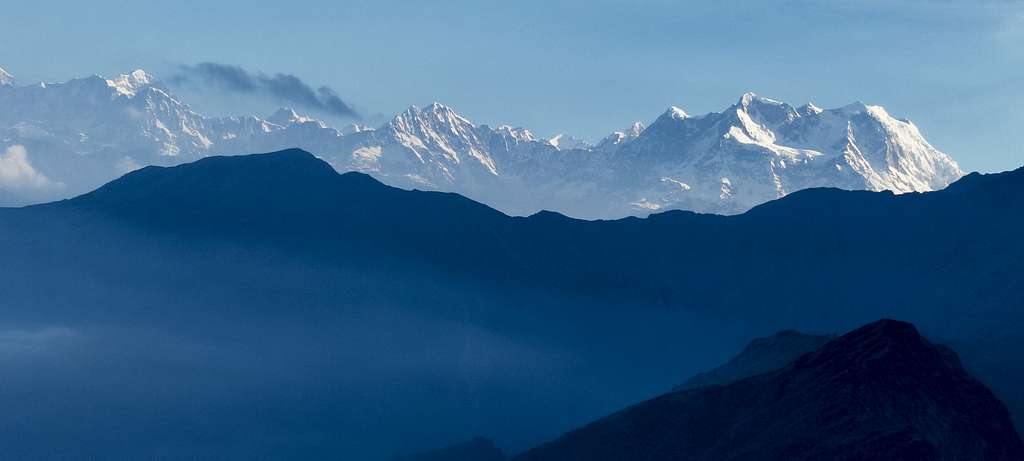
Next day - we got up early to hike up to Chandrashila Peak, which is another 1 km higher than Tungnath. The hike reminded me of how I took my son, who walked at my pace to go to the peak, to witness the sunrise from there.
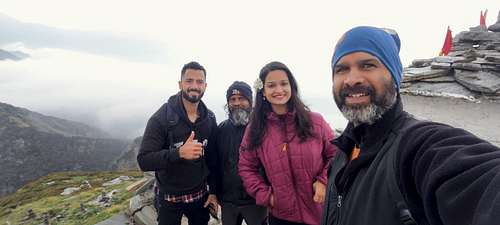

While we were going up, we saw a lot of people coming down, saying that it is going to rain, as a lot of clouds had gathered in the sky and warned us that we shouldn’t be up there when it rains. However, as usual - by reminiscing lord Shiva’s name, we carried on - with a belief that the lord is with us, in case something happens! At the peak, we were surprised to see that we were the only ones over there, and as we spent time there, we saw the clouds parting, giving way to sunlight, and partially opening up the view of massive peaks in front of us.

Chaukhamba is a prominent peak that you see from both here as well as Deoria Taal, provided the weather supports it. I quickly connected with my folks in Pune, and gave them a preview of the beauty that lay in front of me, through a video call. It was indeed mesmerizing. Malvika and Gaurav - two friends from Delhi also hiked up, and we had a great conversation about Himalaya, geology, our experiences, and what brought them as well as here.

She was an IAS aspirant, and he was working in the corporate sector. A couple of clicks later, we exchanged numbers, and parted ways, to re-group again during breakfast and our descent from Tungnath, and further share a ride where they got off for Deoria Taal, and we went to Ukhimath, where Rajib and I had our usual Dal-Chawal, while waiting for the jeep to get filled, so that it can move to Ransi, the base village of MadhyaMaheshwar, the fourth Kedar!
MadhyaMaheshwar
The ride from Ukhimath to Ransi wasn’t too much of a distance, but we weren’t sure of the transport.

Ransi is a very remote village, where only those who want to trek to MadhyaMaheshwar go. Once we reached Ukhimath, I grabbed some cash, as we were falling short of cash for the next leg of the trip. While I gathered cash, I was looking for Rajib, who had loaded his sack onto the jeep, and was happily eating mangoes, which he procured from one of the shops.

I learnt that day that he is very fond of Mangoes.
The wait for the jeep to get filled was killing us, as we had plans of hiking up the trail, at least mid-way the same day. The total hike is about 15 km, with places to rest and stay in the middle. They charge on a per person basis, and provide basic food at reasonable prices.

There was a young sadhu who was accompanying us to MadhyaMaheshwar, right from Ukhimath. Interestingly, he was from Kanpur, but was associated with an ashram in Haridwar, and had been traveling the past few weeks in this region.

After a few more people came over, I and Rajib convinced the driver that we’ll pay for 2 extra people which he was falling short of, for him to get started on the journey. At last, the jeep rattled its way up the road towards Ransi.
Initially, we had planned on doing the trek from MadhyaMaheshwar to Kedarnath, by taking the trail through the mountains, instead of the regular route. For this, we had also taken the requisite permissions from the forest officer as well, so that in case we got stopped at any check post, we could show it to them.

However, with the inclement weather approaching, and rains lashing everywhere, we were suggested by our friends in the Indian Army who had helped us get the permissions, to not venture deep into the woods, as there were very high chances of landslides in this part of the Himalayas. So, despite having the permission with us, we dropped that idea, and decided to do all the Panch Kedars through normal routes, except the one when we connected Kalpeshwar and Rudranath. This change of plan, we also conveyed to Mr. Devender, the guide we had decided on, a resident of Ransi village, who would’ve shown us the route and taken us to Kedarnath.

The RE Himalayan parked outside a home made us identify Devender’s residence, where Om had reached much earlier than us. The jeep driver confirmed with us that we didn’t want to go upto the trailhead (where everybody gets dropped off to start the trek), Devender welcomed us with a cup of tea. It was maybe after 3-4 days that we got a chance to take a bath. So, after freshening up, we left for the trailhead, and were fortunate enough to get a lift for those 2 kms, of course for a price, but that saved us time.

Devender had suggested to us that the sun was going to set soon, so it would be better if we could stop at Gaundar, which was about 4.5 kms from the trailhead. However, when we started walking, we realized that the freshness of the tea and the wash had energized us completely, plus the initial part of the trail was almost straight, with the last section being uphill.


Within no time, we reached Gaundar, and when I and Rajib looked at each other - there was mutual consent without any word - that we should carry on walking.

The next halt was a beautiful place right besides the river, when you cross a bridge and you have homestays right there.

People came running at us in Bantoli, asking us if we would like a place to stay, with good home-cooked food. It had begun to get a little dark, but we carried on, and hiked up another kilometer and a half to reach upper Bantoli. Again, there were people staying there, and we decided to halt for the night over there. A gentleman who was limping because of a disability calmly walked up to us, while we sat on a bench in front of the house - would you like to stay for the night, he asked.

His gentle approach, and the view from his home sold us out, and we agreed immediately. He showed us a room in front of which there was a balcony like structure, from where we could see the entire valley in front of us. The trip from Chopta to Ukhimath to Ransi and further, the hike up to upper Bantoli had tired us out, but a refreshing drink called Buransh juice rejuvenated us. We sat there on the chairs, looking at the clouds coming in from both sides of the valley, and filling up the valley in no time, with partial glimpses of the river undulating in a simmering serpentine motion. At times, it felt as if the clouds were rising up from the river and reaching out for the sky. We could see locals on the trail which cut across the side of the mountain with a few pilgrims resting at the lower Bantoli homestays. I made a quick call from the owner’s phone to Manasi, to let her know that we are doing well, and there’s nothing to worry.

Tired of eating traditional food, I ordered a plate of Chowmein for dinner, while Rajib-da stuck to his usual Dal-chawal. It was a good day of travel, hiking, food, scenery and finally - a good night’s sleep!
We woke up the next morning to rain battering away on the plastic chairs that we had used the previous night, questioning our further hike up to MadhyaMaheshwar. The owner, sensing our situation, immediately sold us ponchos for the rain. Rajib had his own one, from Reliance, so I had to buy one, to save myself from the rain. Although I had a spare set of clothes, I was a bit unsure, if that also gets wet - what would I do? Same was Rajib’s case.

A good, hearty breakfast of Aloo parathas, which took more time than what we had anticipated, we were on our way up the mountain, to the fourth kedar - MadhyaMaheshwar!
As we climbed higher and higher, we could see snow clad peaks peeking out from behind the high walls on our sides, we could see the river getting smaller and smaller, with clouds gathering in the valley which we had left behind.

Crossing a few more places to stay for the night, we entered a section of the trail which reminded me of the poem from Robert Frost - “The woods are lovely, dark and deep…..” With the air being humid, fresh raindrops on the tree leaves, small streams going down the mountain, which we had to jump and cross, or the small impromptu waterfalls that take shape, when it rains heavily. Soaking in all the beauty while we slowly trudged our way up the mountain, to finally reach a spot just before the temple premises, where beautiful sunlight dashed through the clouds and filtered on the trail through the trees, exposing the magnificent scenery behind!

A few pics later, we witnessed the fourth temple in front of us, nestled in the valley with mountains all around it. I immediately shouted out a “Om Namah Shivaay”, with folded hands, and we both headed towards the temple. The advantage of having come up to the temple early in the morning was that we had the entire day to ourselves.
We took refuge in one of the homestays that had “its turn” that day (the owners have a turn system for hosting pilgrims), and then went for the darshan. After the darshan, we chatted at length with the head priest there, who was from Karnataka. He told us, this is his fifth generation of being the head priest at this temple. He told us that there are two families which are responsible for holding the head priest’s position in MadhyaMaheshwar and Kedarnath, while there are others who have the responsibility for the other three kedars. He was quite a jolly fellow, an ardent worshiper or lord Shiva, who recited multiple verses from the vedas as well as other scripts related to Shiva.

To top it all off, Rajib narrated the story of lord Shiva and Sati’s wedding, which distressed her father to no extent. Daksh, the father of Sati, and son of Brahma, organized a Yagya, where he invited all gods to collectively condemn lord Shiva, as he never ever approved the wedding of his daughter to the Adiyogi, one who has matter hair, lives in the cemetery, uses a loin cloth to cover his body, which is forever smeared in ash, and lives like a recluse. He always used to question how his daughter could marry such a person, who had no origins, no parents, no past, and no history of his lineage. This is because as the head priest said, “Har Kankar mein hai Shankar”, which means - there is lord Shiva everywhere, even in the minutest particle; he is omnipresent.

Disgusted with his daughter, he doesn’t invite his daughter to the Yagya, but when she goes home to meet him, she is aghast at the fact that her father had organized a ritual to condemn his own son-in-law! She tries to stop him, but he doesn’t relent, so she gives her own body up in flames in front of her own father, as a symbol of her love for lord Shiva, but disapproval of her father. And, while doing so, her father also doesn’t stop her.

When lord Shiva learns about this, he gets furious, and starts doing the “Taandav”, symbolically opening his “third eye”, reaches the place of Yagya and beheads his own father in law, curses his father, that there won’t ever be any temples of lord Brahma, and carries his wife, Sati to the deepest valleys and highest mountains, in a mourning state from which nobody is able to bring him back! Lord Vishnu is counseled, and he assists in cutting Sati’s body into 52 pieces, which fall at multiple places in India, all of which places are highly worshiped by devotees, who throng to these places throughout the year.
It was amazing how much knowledge Rajib had - be it physics, mythology, space exploration, geology and pretty much anything under the sun!


After lunch and tea (which we had with the most magnificent scenery right in front of our eyes!), we made a great decision - to go up and take darshan of Boodha MadhyaMaheshwar (Old MadhyaMaheshwar) that same day! I call it a great decision because of the views we got, the weather we got, and the very next day, when we were on our way back down, early in the morning, we couldn’t see 2 feet away in front of us, as clouds had just engulfed the entire valley that held MadhyaMaheshwar temple in its arms. We climbed up to the temple, took darshan and then moved further to a vantage point, from where one could witness the most spectacular views of the valley beneath, with endless rows of mountain ridges going down to the river.

I got some really good photos at this spot, with cattle and goats grazing in the meadows, and the valley visible beyond them. The sadhu who accompanied us on the jeep to Ransi was also there, and his saffron robe added a dash of color to the god’s painting visible in front of us, where god must’ve used all the colors on his palette.
The descent was a bit boring, as usual, but we reached just in time for the aarti at the temple. A very interesting incident happened - to avoid taking any pictures during the aarti, the head priest and his team had deployed a small kid to keep an eye, should anybody try to take a photo or a video. And, boy - he found one guy - so he runs up to the guy, and haggles with him till the guy gives up his mobile phone, which he gets to the leader of the priest’s team, who slips it in his pocket.

It was told that in case such cases are encountered, the phone will only be returned to the owner, after a thorough check of the photos and videos, and if any are found, they would be deleted from the phone. The kid was such a cute kid, with his eyesight almost piercing everybody, and I must say, apart from a fool or two - nobody dared to take photos or videos, to be caught by this small policeman!


A very warm and welcoming dinner followed, with us sitting in the kitchen of the homestay owner, his wife cooking warm rotis for us, with a local vegetable which he procured from his small farm right beside his home. A cup of tea later, we tucked ourselves into the bed, after a day of enjoyment of the beauty around.

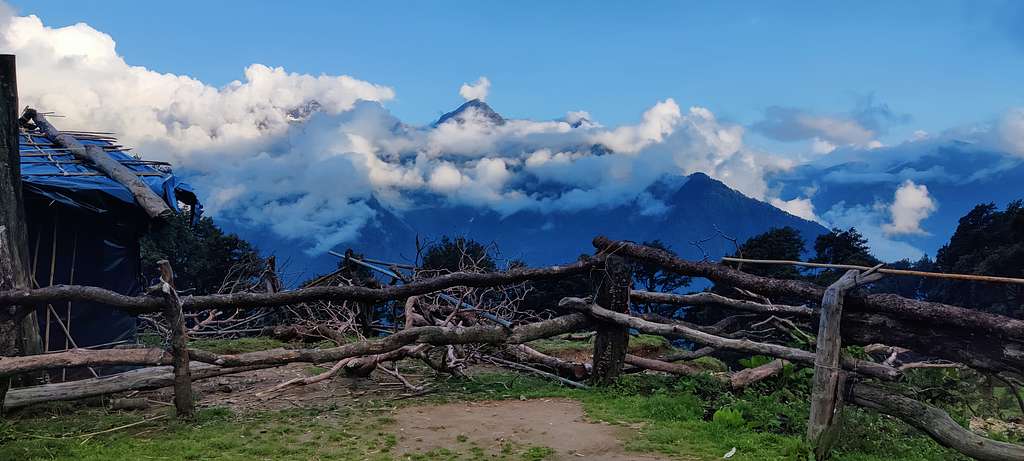

Next day, we headed down the mountain amidst clouds everywhere, and we discussed how fortunate we were - to be able to get the darshan of the main temple, witness the arti, as well as go see the temple of Boodha MadhyaMaheshwar. We felt it was nothing but blessings from lord Shiva, who was enabling our journey without any hindrances, and helping us deepen our faith in him, as days went by!
Kedarnath
A little risky hop and jump on a broken trail, just before we topped out from the MadhyaMaheshwar trail, and a triple ride on Royal Enfield later, we were again at Devender’s home, where we met Om.

While on our way to MadhyaMaheshwar,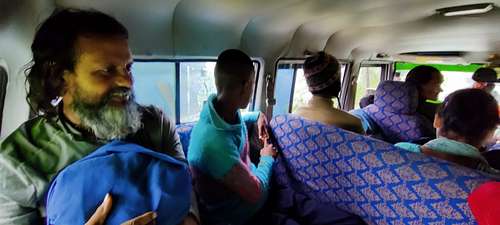
Om had contracted fever, and was completely down and out! However, when we returned, he looked in a much better shape, but we wondered if he was going to go up MadhyaMaheshwar. We doubted. He had gotten out of the zone, where one treks for days altogether, and he had gotten relaxed. Nothing wrong in that, we just felt he missed out on a ton of amazing experiences and beautiful settings, which he wouldn’t be able to see any place else.

The usual search for a ride to Ukhimath ended when a jeep was getting filled, and I just threw my pack on its top and took a spot, however I realized that Rajib had gone for a bath! Hopped out of the jeep, and called him out of the bathroom in the most urgent manner, to get ready and take a seat.
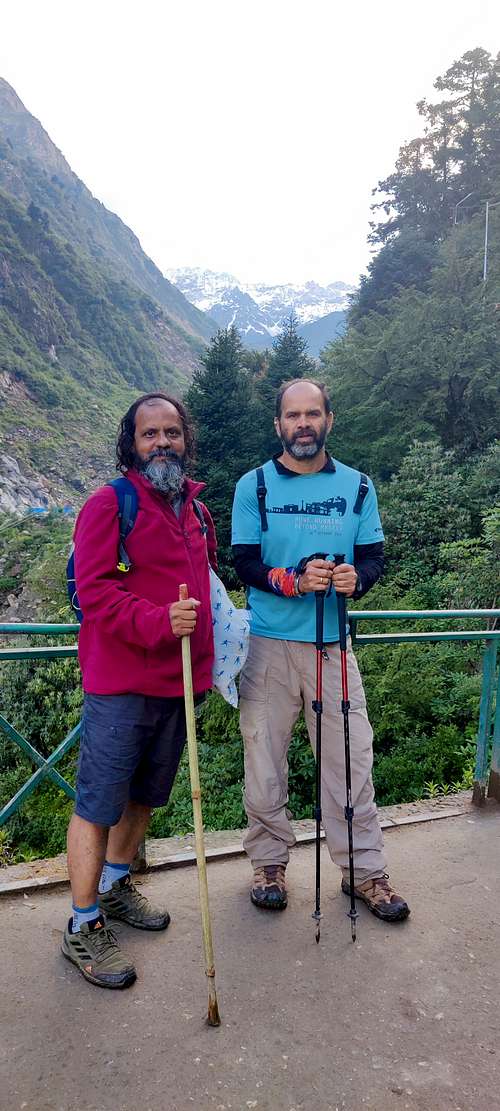
We got the last seats - facing each other. Well, we had to probably get used to this, as we had similar seats on our ride from Ukhimath to Guptakashi, and further from Guptakashi to Sonprayag.
It had gotten late by the time we hauled our backpacks into Gaurikund, from where the trek up to Kedarnath starts. We looked at a place where we could keep them, and take smaller sacks with us, but most of them were just roadside cloak rooms, where we didn’t feel our luggage would stay safe.

Bang opposite the Gaurikund temple, I saw a steep staircase going up, with a sign that read Hotel and cloak room. I immediately rushed up, and we deposited our sacks over there. It had been quite late in the afternoon, but as we had planned on hiking up a part of the trail that day itself, we had a late lunch which was very much required for the energy levels required for the hike. A quick bite into a paneer curry and rotis got us going, and we headed up the trail.
The trail at first, disgusted me to the core! It was a cobbled trail, with long steps, full of pee and horseshit all along, everywhere, and you had horses and ponies, with pilgrims delicately balanced on them, wobbling front and back, coming down the trail in no specific order or pattern, which means - if you don’t pay attention, they will come and ram straight into you! The trail was lined with stalls where people were selling everything from tea to various kinds of snacks, people lined up outside the stalls, sometimes being decent enough to throw the litter in the garbage bins kept there, or sometimes - just throwing them right on the trail itself! So, the combination of the pee, shit, garbage, groups of people, ponies (one after the other) rushing towards you, and you trying to avoid them by either going to one side of the trail or another - all of this was indeed a result of extreme commercialization of the Kedarnath yatra, as compared to the serene yet tough-to-reach Rudranath and MadhyaMaheshwar yatra, where the trails meander through meadows, hill-tops, forests, and over bridges over rivers and rivulets. At every step I took, my mind used to wander away to the massive mountains with clouds filling up the valleys, and snow clad peaks peeking from behind them, all the while when we inhale fresh, moist air of recently fallen rain, with dewdrops mildly making us wet, while we navigate through the trees. And, while my mind is ruminating over the earlier pretty trails, a sudden neigh from a pony right in my face snaps me back to reality, and it's as if I gain consciousness.

It was getting darker, so we discussed where to halt for the night, and decided on Bhimtal, which had a GMVN accommodation at around 7 km from the start. On the trail, one can see tents pitched (most of them Quechua), which the dhaba owners pitch at whichever location they find, and they charge a bomb to the pilgrims who come asking. Each tent is mostly a two-person tent, for which they charge somewhere around 2 to 3 thousand rupees per night, which is exorbitant.

For the washrooms, there are always those common ones, which are constructed by the government on the trail. Overall, the condition wasn’t so good, but I guess people don’t have much of a choice.
Further, along with people riding ponies, we could see people being carried on the backs of people, as well as being carried by four people. As much as we pitied the people who carried humans on their backs, we understood that it is earning livelihood for them. Also, the four people who carried a person seated in the middle (like a carriage) walked in total sync with each other, with everybody’s steps and breath in total harmony with each other. Both of these were tough jobs, we felt, especially when we saw pilgrims haggling with them over the rate. Rates are known to be standardized for these rides, however people still want to reduce it, and sometimes owing to competition, they buckle under pressure.
Bhimtal campsite was buzzing with people, with accommodations on one side of the road, which was on the river side, while the restaurant was on the other side. The charges for one night included the dinner, however he reduced them for us, as we really didn’t feel like having dinner (after having had the late lunch). The guy at the reception marginally reduced our fare, and we headed to the dormitory, to finally lie down our tired bodies, of all the travel, followed by the hike up.

The dormitory was already occupied by a couple of people, and we chose our beds. A quick visit to the restroom validated the fear that there was no water in the washroom. The two guys who were sleeping on the beds were actually working for the Uttarakhand Electricity Board, with a huge responsibility of ensuring that there is no power outage. With incessant rains lashing the trail on and off, the grid used to fail, and these guys used to run, getting up from bed. Poor guys, we felt for them, even though we were cursing that our phones weren't charging, due to the intermittent power.

Ignoring the massive spider on the ceiling, but brushing away a couple of small ones from the bed, I dozed off after yet another hard but satisfying day on the mountains.

The next day started a bit terribly, with washrooms with no water, but we somehow managed to find a spot in other toilets, which were meant for the tent accommodations.
The hike up to Kedarnath continued along the route, which abruptly turned across the river and went on the other side. It was only after crossing over that we could see the massive destruction of the earlier route and what used to be called a place called Rambara, enroute the shrine. It was all gone - wiped off from the face of the mountain! We couldn't imagine how people must've felt, with slopes slipping away from beneath their feet, and water gushing down from above, with practically no time to think, on how to save one's life. It was a sad reminder of what happens, when we humans tend to take nature for granted, for our own greed!
Rajib was hungry, and without fuel, the car won't run, so we took a halt for a Maggi and coffee break, and resumed our journey to reach the final point, from where even horses are not allowed further. Everybody has to walk from this point onwards. From here, one could see the top of the Kedarnath shrine, and with the clouds parted, the massive Mt. Kedarnath at the back also gave us it's glimpse! What a sight it was! Marvelous view, while chanting Om Namah Shivaay was something to remember.
We moved ahead with the goal of seeking Darshan as the utmost priority, while accommodation not even being a priority, which wasn't a good plan, as we realized later. As soon as we reached closer to the entrance, we saw a line for the Darshan, and we immediately queued up, with shoes and sack safely kept at one of the stall owners nearby. It was such a coincidence that he was from the village of Ranai, which we had just returned from, a day ago.
The line was huge, but amidst all the chaos, we could seek the Darshan of lord Kedarnath, and we felt blessed! This is the place where lord Shiva is supposed to have entered the earth, and hence the rear portion of the bull is seen at this shrine. The shivling that we saw during the Darshan was in the form of a hump of stone, which was being worshipped, while a beautiful statue of Nandi sat in front of it, waiting permanently.

Once out of the temple, we saw a huge crowd going towards a particular sadhu. Someone told us that he is an integral part of the evening aarti and is the one who got famous because of the movie Kedarnath, featuring Sushant Singh Rajput. Nowadays, he charges money for getting a picture clicked with him, and people throng to him like bees!

Being tired of the climb, we walked into a dhaba, and had a heartful of Poori Subzi, and started looking out for accommodation. People here charge heavily for providing rooms, all the way from 1,000/- to 10,000/- per night, depending on how many of you are there, and how adjustable you are. There are homes and ashrams, where people have used all the nooks and corners to pitch tents, sometimes literally in the corridors outside the rooms, where they charge a thousand rupees per person. Having an attached toilet is the utmost luxury at this place.

The tents usually come with a wire dangling in through the roof, which is split into two - one to be used for light, has a bulb attached to it, and two, it has a pin, where you can charge your cellphone. Simple. You want to use the washrooms - use the ones which are available, based on vacancy. God knows what one would do, in the case of an emergency.

After going through multiple rooms, we bumped into a guy who said - 300/- per night! We initially thought, we heard it wrong, but he reiterated, 300 per person, per night!
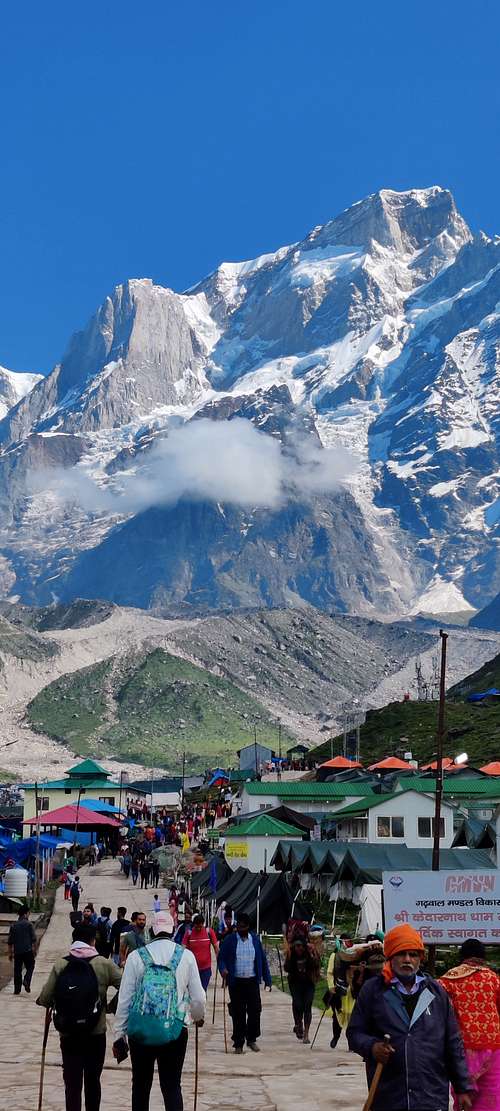
In the 2013 destruction, the only other structure that didn't get washed away, apart from the Kedarnath temple, was this very house called The Nepal House. Built around 125 years ago with old style architecture, this house withstood the brunt of the calamity by almost getting half filled with sand and rocks, but not falling apart. Surely, cracks were visible on a few of the walls, but overall, the structure stood firm, mocking others and proving to them, that old is gold!
The guy pulled out two mattresses and two comforter like pieces, which resembled very much to the mattresses. He dusted them with a stick in front of us, and lay them down in the sun, for them to get "rejuvenated" from the old godown it had been lying in, God knows for how long! We sat there, tired but with stomachs full, waiting for the mattresses to get alive again, so that we could rest a little.
Half an hour later, the guy seemed convinced that the mattresses are "fresh", as if out of a laundromat, and he spread them for us in a separate room. At first, I thought the room smelled of something bad, but ignored it, and we lay down. The cracks on the walls and the creaky ceiling wasn't a bother for us, as we had two things inside the room - electricity, in the form of a dedicated bulb for us, and a socket, to charge our phones.
Rajib started snoring within no time, and in that rythmic noise, I also slept off within no time, only to awake due to that certain smell, yet again.

Both awake, we went for another Darshan of lord Shiva in the Kedarnath temple, and to our surprise, there was no queue this time. We just walked in, and took Darshan with folded hands, standing in front of the deity for a while, with nobody pushing us to move ahead. It was a great experience, to be able to do this at leisure, which is quite rare at this shrine. After the Darshan, we went and visited BheemShila, the huge boulder that mother nature sent hurling down the face of the mountain during the 2013 catastrophe, to save the temple of Kedarnath!

It's amazing, how, amidst the entire flow of water, rocks, mud and whatever that came down during the downpour, this huge boulder came rolling down, and miraculously stopped just short of the temple, at its back, and dug it's feet there, so that all the water that came flowing down from behind the temple stuck the boulder first, got diverted to the two sides of the temple, and continued down!

Those whose lives were saved during the tragedy were witness to this miracle that saved their lives, when the head priest allowed them to take shelter inside the temple. He allowed as many people as he could, and all of them were saved. This is nothing short of lord Shiva's blessings that a boulder flows down with the rubble, and helps divert the flow of water from behind to two sides of the temple. Along with offering prayers at the temple, everybody also makes it a point to offer prayers at the boulder, which is now revered as much as the temple! This was followed by a visit to the Adi Shankaracharya monument that was recently built by the government at Kedarnath, as it is said that it was Adi Shankaracharya, who built this, among many other temples all across India. Rajib also told me of his fascinating story when as a boy, it was difficult for his mother to gulp down the fact that he wanted to be a sanyasi, right from childhood. He went on to become one of the most revered saints in India, and the Govt of India had done a fantastic job of erecting a monument in his honor at Kedarnath.

There, we met a lady from the state of Maharashtra, who had trouble walking, and had come with her daughter and son in law, who had come down from Australia. She was more than 65 in age, heavily set, and was a devout Shiva follower, and was visiting the temple maybe 50th time, in her lifetime. She had trouble lighting the incense sticks she had, which we helped her with, while we got chatting. Her son in law was from the royal family of Baroda, but was settled in Australia. She had come on a pony, and had plans of descending via a helicopter ride. Little did she know that the weather was going to take a turn for the worse, and she would have a tough time descending, which we witnessed the next day.

On returning from the boulder to attend the aarti scheduled at 7 pm that day, I lost Rajib in the crowd. I wasn't getting any connectivity, so I was relying on his phone to show the aarti to my folks via a WhatsApp call that evening. During the day, I had already helped them witness the temple and the surrounding beauty, which gave me a deep sense of satisfaction, as my father is an ardent devotee of lord Shiva, has been to Kailash Manasarovar yatra, Amarnath as well as multiple Jyotirlingas, but had his plans of visiting Kedarnath foiled, not once out twice, but thrice! He had told me before leaving - it is only if the call comes (from lord Shiva), that your pilgrimage will finish. If you ever feel there's any risk anywhere, please don't go; it means, the time hasn't come!
Having him and my family witness the temple, having my cousin, Rucha and her mom (Sandhya Kaku) witness the temple was something I felt very pleased to do from the bottom of my heart, as we weren't aware at that time, that Sandhya Kaku would soon leave us, for good.
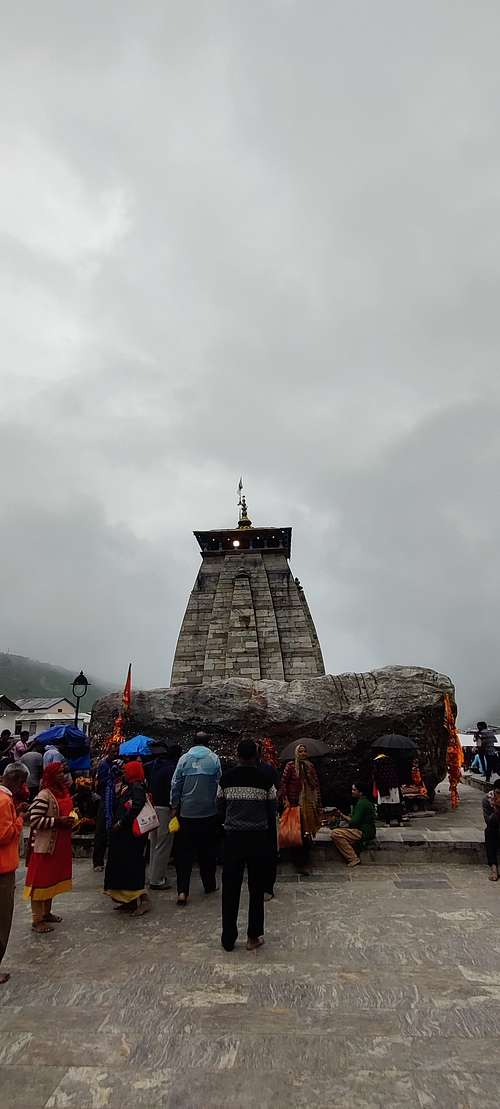
The aarti began amidst chants of Om Namah Shivaay Jay Bholenaath; with the whole crowd swooning in the hymns after the aarti, soaking it all in, hands folded, eyes closed, while some - who had connectivity, were helping their folks back home witness the grand spectacle at one of the most revered shrines in India!
During the aarti, all of a sudden, Rajib appeared out of nowhere, and stood besides me. He had white ash smeared on his forehead, and he wore a smile. Upon asking him, he narrated a mysterious incident of a Sadhu, who got very famous during the movie Kedarnath, when the actors took pics with him, and he became a centre of attraction for everyone. So much so, that people wanted a pic with him, for which he used to charge around 500/-. When we were returning from the Darshan in the afternoon, we had seen quite a few people around him, wanting to take a pic. What a way to earn money, we thought. This is what celebrities do, and he wasn't anything shorter than a celebrity Sadhu.

However, when Rajib was returning from the Bhimshila, while I proceeded towards the aarti, the Sadhu called Rajib, not once but twice! When Rajib refused, as he wasn't interested in taking a pic with him, he shouted at him from a distance, telling him - "Don't worry, I won't take any money from you. Bhut, you are special and I want to bless you!" With those words, Rajib walked towards him, and before he knew it, an ash smeared hand brushed past his forehead, with the ash getting transferred to Rajib's forehead. With his blessings, this happy soul was standing in front of me, all smiles.
The aarti concluded, and post a hearty dinner, we made our way to the Nepal House, but when we entered the room where we slept in the afternoon, I couldn't bear the stench that filled the air. When asked, the guy told us that it's been there ever since, and didn't we notice it in the afternoon?

Apparently, there was a gutter flowing right behind the wall where we rested our heads, and the stench from it was totally unbearable! Upon requesting the guy, he gave us a spot in the huge middle hall, that was the centre of the house, where a couple of people were smoking.

I requested them to kill the cigarette, and one of them did, with a smirk. The caretaker pulled out our mattresses and blankets from the other room, and dumped them in front of us, telling us that this room is nice.
Lying down, when I was about to doze off, something crawled from one side of my head to the other. I was almost going to stomp whatever it was, but was shocked to see a rat walking away calmly, as if he had merely crossed over a bridge!

I am not afraid of rats, but got frightened by the possibility of getting bitten by one, and I immediately got up. I convinced Rajib (who had slept off) that we needed to move out, and look for another accommodation. He reluctantly agreed, and at 10.30 pm at night, we were roaming the "Mall Road" of Kedarnath, looking for accommodation! One guy tried to convince us to sleep in a Quechua tent, perched on the landing of stairs going to his home's terrace. It was so precarious, that nobody would occupy that, but for which he was ready to reduce the rent as well.

Shopping for accommodation was very expensive, which ranged from 1000 per night to 12000 per night. We managed to get 2 bunk beds in a GMVN dormitory, where we "tried" to sleep, with people around us, either watching videos on the phone, talking loudly, or the Bengali guy next to us, snoring his guts out!

We realized the next morning that the Bengali guy and his wife had come all prepared, with a camera, binoculars, goggles and the ultimate thing was when he put on an ironed shirt and pants from his suitcase. It seemed they were on a picnic to Kedarnath, just that the picnic basket was missing. The common restrooms having no water didn't help, as there were so many people around, that you couldn't take a dump anywhere in the open.

We had planned on going to Vasuki Tal for a hike, so we set out by crossing the river Alaknanda via the bridge that is constructed right before you enter the Kedarnath complex.

The route was a bit tricky to find, but we managed to find the trail. This is the last campsite on the Auden’s col trek, which connects Gangotri to Kedarnath. This is a separate Vasuki Tal than the one which one sees at the base of Vasuki Parbat, while climbing Bhagirathi - II. When we covered around 2.5 km, the clouds started to come in from the valley beneath, and within no time, there was a complete whiteout. While the whiteout was happening, we witnessed one of the most spectacular sights of the Kedarnath valley open to the sky, and covered in clouds the next minute. While we were searching for the trail, we saw a few hikers at an elevated place in the mountain high above us, and a quick shout-out to them led us to start our return journey. It wouldn't have been a good idea to get stuck in the rain and hail, plus we didn’t have any spare clothes, so had we gotten wet - we would’ve had to walk all the way back to Gaurikund in the same wet clothes. 
A turnaround from the 2.5 km mark, we crossed over into Kedarnath, and decided to not go for another darshan, as rain was approaching, and we thought it’s better to descend as soon as possible. So, we just packed out stuff in the small sacks that we had, and started our descent. Rajib was hungry, so we took only a small break at around 12 noon, for a plate of Maggi and tea, and continued our descent.

Upon reaching Gaurikund, and collecting our backpacks, we were all set to spend the night at Sonprayag, but as soon as we got into a jeep to go to Sonprayag, we saw police officers rushing past us, running towards the front. We were told that the jeep ahead of us had experienced a rockfall, and three people had died in it, so within an hour or so, all vehicular traffic and the yatra was suspended for two days. We had to take our huge backpacks and walk another 7 km, before we reached Sonprayag. I reached a bit early and I bumped into a driver who was looking for passengers to take them to Rudraprayag.

I thought about it for a while, and decided on the spot, to change the plan of staying in Sonprayag, and descend all the way to Rudraparayag, from where we would easily get transport. This was about 6 pm, when I almost snatched Rajib’s backpack, put it on the top of the jeep, and forced him into the jeep for the return journey. He seemed a bit frustrated, as there was practically no rest for him or for me since the time we started our hike to Vasuki Tal that morning.
The return journey was in a full blast of rain, and we couldn’t even dare to wonder what it would be like up there - in Kedarnath. Dinner at 10.30 pm was our first meal of the day, and we had a nice sleep in an air conditioned room after a long time.

The next day also it was raining heavily, and we didn’t get a bus to Rishikesh, which typically comes into the city, where we had intended to board it. But now - the money people were asking for taking us to a point outside the city, where we could board - was just ridiculous. We both walked the distance of around 2 km, before we were given a lift by a doctor, who was on his way to the hospital in Rudraprayag.
In hindsight, it was such a good decision that we descended down from Kedarnath as early as possible, because the bus that we boarded from Rudraprayag for Rishikesh was stopped, along with all other traffic for about 6-7 hours, as an entire section of the road ahead was washed away! There was a row of vehicles, which was stuck, and people missed out on their further reservations due to this natural disaster. Like everyone, we started looking out for a lift to Rishikesh, on a smaller, less wide road where buses and trucks weren’t allowed. We started walking, sticking our thumb out, and we were fortunate enough to have been picked up by 2 kids who were from Gaurikund, and were on their way to Rishikesh. A long journey later, we arrived in Rishikesh at 10.30 pm, and then a bus ride plus a 1 km walk later - we were at Rajib’s uncle’s place.

Rajib’s uncle is an interesting personality, who is so interested in spiritualism that he decided to settle in Haridwar, post retirement.

His family stays in Kolkata, and his kids are well settled, both in India and abroad. At his place, he got excellent food made for us, all in traditional Bengali style - eggplant, chicken, fish and paneer, with potato, all cooked in mustard oil. All the while while we were there, he narrated incidents of his and his friend’s experiences which were truly spiritual in nature. He had been an ardent planchette practitioner, but had to quit when he found out that he was addicted to it. While doing planchette, he had called spirits of many people he knew, including his great grandfather, with whom he struck a conversation. There were many stories where the spirit assisted him and his family in present circumstances, which sounded eerie but were entirely true. He told us of a story of how Ramakrishna Paramhansa disregarded the way previous gurus were preaching, found a fault in their methods, and how he was a practical spiritual guru, and who always promoted “how to find yourself”. All this while, we were sitting there, bewildered, listening to him tell us about the books that have inspired him, while chatting with his friend, a top former bureaucrat who had worked with the likes of Dr. Montek Singh Ahluwalia and Dr. Manmohan Singh, the former Finance Minister and Prime Minister of India!








Faith
All in all, it was a great trip with a colleague from whom I got a chance to learn so many new things.

What amazed me the most was the blind faith that he put in me, when he decided to come along on this spiritual journey. He didn’t have any idea about the Panch Kedar, nor had he ever thought of visiting them ever in his life.
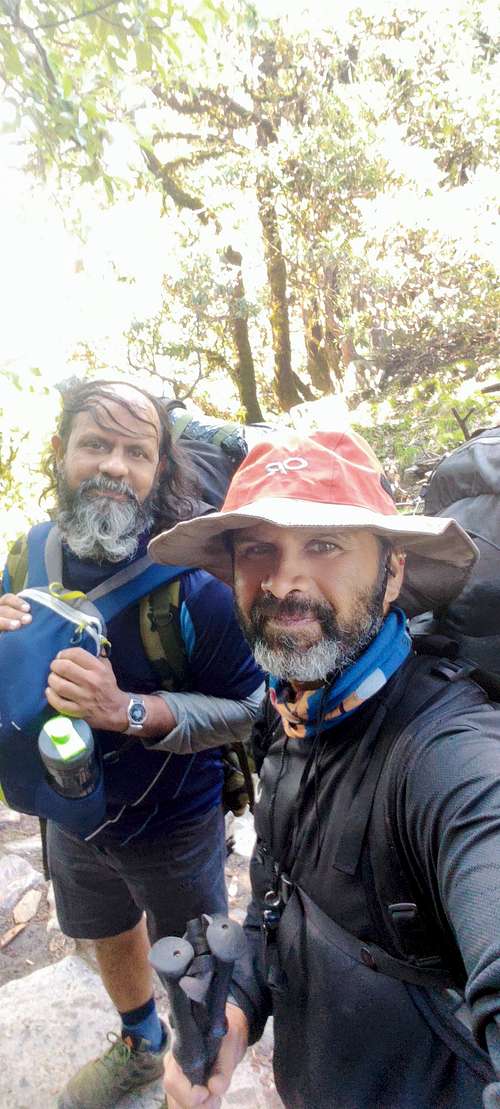
He just knew that his wife was a staunch Shiva devotee, and that someday, he would have loved to take her to Kedarnath, as they’ve had one failed attempt earlier.
It was a week before booking my tickets, when I asked him - Rajib Da, would you like to come along? He asked where - and I said - Panch Kedar.
Never did he ask where we are going, what’s the plan, itinerary, eating arrangements, sleeping arrangements, bookings, travel - nothing!
He simply put his complete faith in me, and to our surprise, the journey comprising of a total of 8995 m of ascent, over approximately 148 kms, within 8-9 days that unfolded in those days - will always be remembered by both of us - for the rest of our lives!



